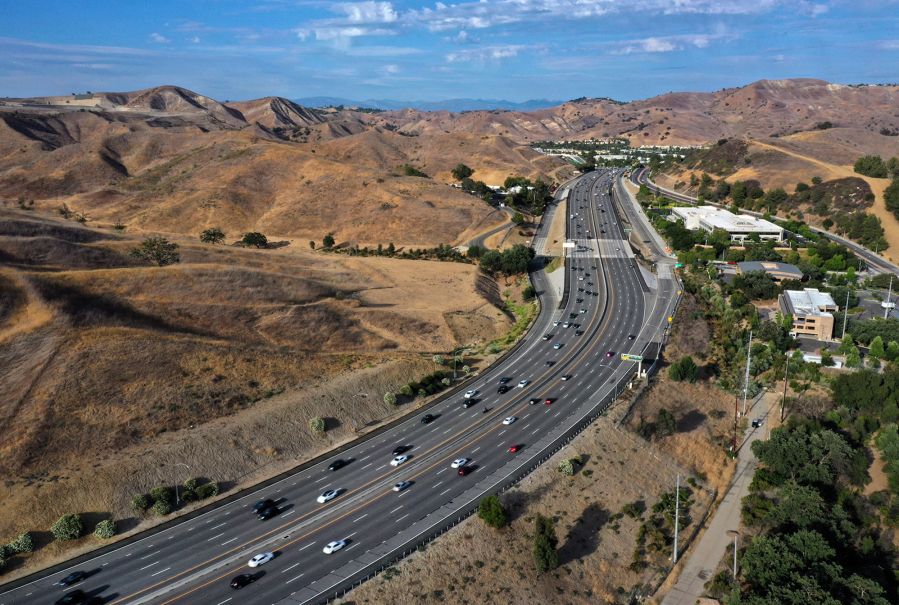LOS ANGELES — Chalk one up for the cougars.
When conservationists first announced plans to raise $30 million for a wildlife crossing over a deadly 10-lane stretch of the 101 Freeway in Agoura Hills, critics snickered and said “good luck.”
Now, 10 years later, the dream of building a bridge that would help mountain lions escape an “extinction vortex” by providing them safe passage to food and mates is becoming a reality.
On Friday, Earth Day, hundreds of conservationists and legislators will gather on a weedy hill overlooking the Liberty Canyon Road exit to break ground on the Wallis Annenberg Wildlife Crossing.
“We did it!” shouted Beth Pratt, regional executive director of the National Wildlife Federation. “For years to come, this wildlife crossing will be admired and studied as proof that humans and wild animals can co-exist,” she said as she raised her voice over the din of traffic streaking past.
With completion scheduled for 2025, the wildlife crossing ranks among the most ambitious apolitical campaigns ever waged in Southern California.
More than 5,000 individuals, foundations, agencies and businesses from around the world contributed expertise and donations totaling more than $77 million — including $25-million challenge grant from Wallis Annenberg and the Annenberg Foundation.
Partners include the National Wildlife Federation, the National Park Service, Caltrans, Mountains Recreation and Conservation Authority, the California Department of Fish and Wildlife, the Santa Monica Mountains Conservancy, the Resource Conservation District of the Santa Monica Mountains, and the architectural firm Living Habitats LLC, among many others.
Because the project spans an interstate, Caltrans will oversee design and construction — but the transportation agency is not providing funding.
The 200-foot-long, 165-foot-wide bridge will be the largest of its kind in the world and will serve as a lifeline for small, isolated populations of cougars in the Santa Monica Mountains to the south, and in the Simi Hills and Santa Susana Mountains to the north.
These 12 to 15 mountain lions have the lowest genetic diversity documented for the species aside from the critically endangered Florida panther. Scientists say they face extinction probabilities of 16 percent to 28 percent over the next 50 years.
“We know the harm done to wildlife by the nation’s highways — and how to fix it,” said Tiffany Yapp, a biologist at the Center for Wildlife Diversity.
“Beyond overpasses,” she said, “we can upgrade existing culverts to be more wildlife-friendly, install roadside fencing to guide animals to existing underpasses, and consider mistakes of the past when proposing new development.”
Roads that are deadly for wildlife can also be dangerous for drivers. More than 44,000 wildlife-vehicle collisions were reported on California roads from 2018 to 2020, resulting in human deaths and damage totaling about $1 billion, according to the UC Davis Road Ecology Center.
The notion of helping the solitary, elusive predators cross the freeway was inspired, in part, by the 2012 discovery of an extraordinarily wayward 3-year-old, 140-pound lion lurking in the shadows of the populated hillsides and attractions in and around Griffith Park.
In his 20-mile odyssey eastward from the Santa Monica Mountains, P-22 had dodged commuter traffic, traversed backyards and maneuvered through an obstacle course of culverts, bridges and roads before making a home in the park’s rugged backcountry.
With P-22 as its poster puma, the nonprofit #SaveLACougars campaign kicked off in 2014 after the National Wildlife Federation and the Santa Monica Mountains Fund joined forces to raise funding for a wildlife crossing unprecedented in scope and cost.
Skeptics doubted that Americans would decide Southern California’s imperiled predators were worth the money. Or were they just another fad?
It was a question that Pratt pondered after taking on the job of managing the campaign, and having a likeness of P-22 tattooed on her upper left arm.
Wildlife crossings, she soon learned, are a hard sell: You need money to get past the blueprints, but you need blueprints to generate donations.
By 2020, the campaign still needed to raise tens of millions of dollars to avoid costly delays and complete construction on schedule by 2025.
Around the same time, biologists began to see physical manifestations of extremely low genetic diversity among several of the cougars who roam 275 square miles in and around the Santa Monica Mountains — a kinked tail like the letter “L,” only one descended testicle and abnormal sperm.
The dire prognosis — what biologists call an extinction vortex — raised an urgent question: How long before it is too late to save them?
“It’s a pivotal moment for conservation and our park,” said Seth Riley, wildlife branch chief for the Santa Monica Mountains National Recreation Area. “It’s super exciting to see the science that we’ve worked so hard on for so many years result in concrete action to benefit wildlife.”
As envisioned by architects and Caltrans, cougars will move — unseen by motorists — over a reinforced concrete-and-steel crossing landscaped with irrigated native vegetation, including oak and willow trees. Sound walls and light deflectors will dampen the noise and headlights of the roughly 300,000 vehicles that pass through the area daily.
Fencing up to 12 feet high would funnel wildlife including mountain lions, bobcats, deer, coyotes, skunks, badgers, squirrels, mice and lizards over the passage. To reduce roadkill, fencing would also extend several miles in both directions from the project footprint.
Though the project is driven largely by the need to connect landscape, another challenge involves development of “natural-looking” abutments, approach slopes and walls expected to provide potential homes for small animals, birds and insects.



